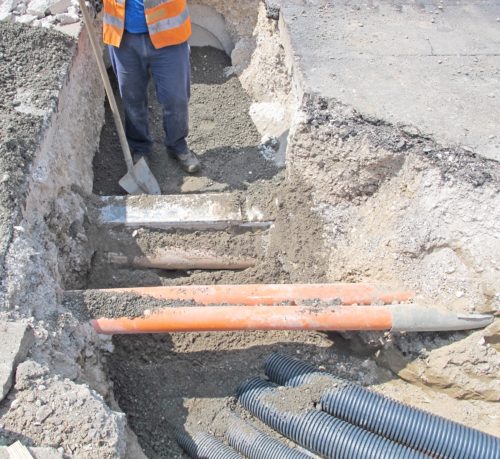How Deep Must Electrical Conduit Be Buried?

Have you ever wondered how deep an electrical conduit needs to be buried? Or perhaps you’re undertaking a landscaping or construction project and need to know how deep to bury electrical conduit.
For safe electrical installation, these are crucial questions. We will provide guidance on how deep electrical conduits must be buried, based on various factors influencing the depth. Keep reading to learn more.
Start by planning to bury liquid tight conduit (LFMC or LFNC) 24 inches deep. This meets general National Electrical Code (NEC Article 300.5(A)) guidelines. Then consider the location and climate conditions where liquid tight conduit might be buried at a different depth.
The common reason for burying electrical wiring is to protect wiring from wind damage and exposure to extreme weather. However, regions that have extreme cold conditions (such as Alaska, Minnesota and parts of Canada) require deeper burial of building foundations, pipe and conduit.
NOTE: Call before you dig. Call 811 in the USA. Utility personnel can identify underground utility lines and mark ground to make sure your digging is not dangerous.
Understanding Electrical Conduit
Electrical conduit serves as protective piping for electrical wiring. Conduit can be metal or plastic and comes in different sizes to accommodate bundles of wire. The National Electrical Code (NEC) governs use of conduit, providing standards for how much wiring may fill the conduit and how many turns the conduit may take. If you install wiring, pulling wire through conduit is easier when there is plenty of space in the conduit, with few turns.
The primary function of conduit is wiring protection from elements like moisture, heat, corrosion or mechanical stress. Conduit shields wiring from abuse, preventing wiring from breaking, delivering a shock or causing a fire. Wiring protection is essential for electrical safety, so conduit is required in the building codes of most countries. Moreover, conduit can be a bonding or grounding device in an electrical system. Also, conduit organizes wiring so that troubleshooting and repair is easier, allowing critical circuits to be routed through color conduit for quick identification in an emergency.
It’s important to carefully evaluate the specific location and environmental factors to ensure the best choice is made. Knowing how deep electrical conduits need to be buried is crucial to ensure electrical safety. Properly burying the conduit sustains wiring protection and makes repair or improvement easier.
Factors That Influence the Depth of Electrical Conduit
The depth at which electrical conduits must be buried varies by location and purpose. These include:
- Location: Different regions have types of soil that make deep burial difficult. Consult local authorities or building codes to determine the depth required for your specific location.
- Type of Conduit: We recommend liquid tight conduit, either metal conduit with a PVC cover (LFMC) or flexible non-metallic conduit (LFNC). We recommend UL listed liquid tight conduit, tested and proven for crush and corrosion resistance.
- Local Building Codes: Building codes protect owners from loss, making sure buildings can be insured and ensuring safety and reliability through years of use. It’s crucial to consult local building codes to determine the minimum burial depth required for your specific project.
- Plan ahead: Call your utility service to identify the location of existing lines. Measure twice and bury once. Make a straight shot between your power source and the intended outlet–fewer turns in the conduit make pulling wire easier. If providing temporary power for an above-ground pool or an outdoor grill, lightweight PVC LFNC may be all you need to bury to protect wiring for a summer. However, if you are planning on powering a new garage or outbuilding, install larger conduit that gives you flexibility and opportunity for upgrades, saving later expense.
How Deep Should You Bury Electrical Conduit?
As mentioned earlier, burial depth varies with conditions and locations. However, as a general rule, most safety codes require burial at 24 inches. This depth provides adequate protection and minimizes the risk of damage. Under concrete or roadways, conduit may be buried at 18 inches. However, local building codes may require a depth that avoids frost heave in areas with extreme temperatures and deep ground freezes.
It is worth noting conduit must be installed without crushing force, impact, water intrusion, corrosive chemicals or exposure to high heat. Even though LFMC and LFNC conduit is flexible, it can be damaged by abuse.
Here is a list of ANACONDA SEALTITE® conduit suitable for Direct Burial and in Concrete.
Your Go-To Partner for Secure and Smart Conduit Solutions
Understanding how deep electrical conduits must be buried is critical to any construction or landscaping project. The proper burial depth ensures the safety and longevity of the electrical system, minimizing the risk of accidents while ensuring compliance with building codes.
Ready to start your next project or need assistance with electrical conduit? Anamet Electrical, Inc. is here to help. Our sales representatives are near you, experienced and knowledgeable about local requirements. Contact us for more information, contact a sales representative or request a quote today!
For an overview about the benefits and issues with Direct Burial, see the document What is Direct Burial?

